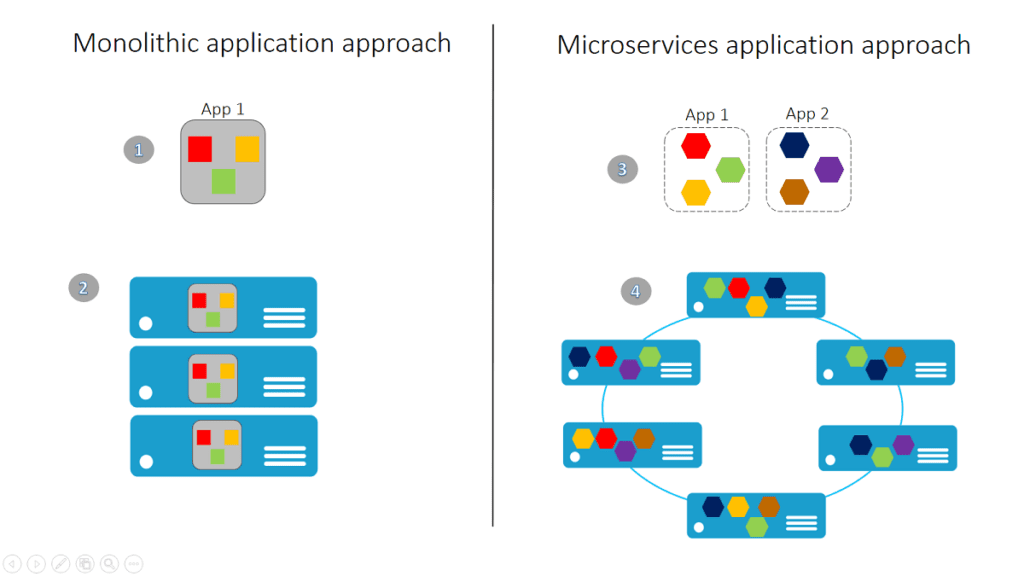When it comes to application development, business needs are changing. With the expanded capabilities of cloud computing, companies are under pressure to build applications that can continuously evolve and expand, while being available 24/7.
Organizations must deliver features and capabilities faster to meet customer demands. Application downtime isn’t an option for most businesses. They need to keep their applications relevant and accessible — or they risk losing business.
Companies are adopting a microservices design approach to make applications agile and reduce costs.
What Are Microservices?
Certain types of applications are easier to build and maintain when they’re broken down into smaller, independent pieces. Each component, or microservice, is separately developed and maintained. The application is a sum of its components.
Microservices work together to deliver the application’s overall functionality. Each microservice has well-defined API contracts to communicate and share data with other microservices.
Microservices are ideal for agile development projects. The smaller, independent pieces decrease delivery time, and each microservice can be deployed, tweaked and redeployed independently without compromising the application’s integrity.
Challenges of Monolithic Application Design
Traditional applications are developed in one piece. This is known as monolithic application design.
Monolithic apps are split into three tiers: a front-end user interface, middle tier business logic and back-end data store. The complete package is deployed onto pre-scaled hardware.
A monolithic application is challenging to scale. The app’s tiered layers are tightly connected, and you can’t scale individual components. If you overestimate usage or the application outgrows its hardware, you need to upgrade the hardware to add capacity and avoid software re-architecture, adding significant costs and resources.
It’s nearly impossible to be agile with monolithic applications. Any change to the application’s service requires that you retest and redeploy the entire tier. A hardware failure can take the whole application down.
Monolithic applications also require you to commit to the technology stack you choose at the start of development. If you build your application on a platform framework that becomes obsolete, it’s difficult to migrate. There’s a chance you’ll have to rewrite the entire application — a serious time commitment and financial burden. 
Benefits of Microservices
Microservices architecture fits the agility, scaling and reliability needs of modern cloud applications.
The benefits of microservices include:
- Efficient development. Microservices have short development cycles and spin up functionalities faster than a single large team working on monolithic applications.
- Isolation. Microservices are updated independently of each other. If one microservice breaks down, the rest of the application can function while you fix the component, minimizing downtime.
- Scalability. Microservices can scale independently to meet increasing demand.
- Agility. You don’t need to rely on a specific technology platform to maintain microservice applications. Individual teams can use any coding language they want based on skills or what’s most appropriate for the specific functionality.
A microservice architecture is cost-efficient, flexible and available 24/7 – benefits not easily achieved with a monolithic application structure.
Microservice Application Platforms
Before you begin developing microservice applications in the cloud, you need to choose a platform. A microservices application platform with robust DevOps tools takes the benefits of microservices a step further.
A microservice platform provides the services needed to deploy, upgrade and monitor your components. It helps you maintain the health of your microservices and make safe and reliable upgrades. The platform also automatically moves your microservices to healthy VMs or servers if the software or hardware they are running on fails or needs to restart.
Microservice application platforms let you use any technology to build microservices across public, private and hybrid clouds, alleviating concerns about vendor lock-in. Platforms like Microsoft’s Service Fabric also provide built-in programming APIs to streamline the building process.
It’s critical to focus on building applications to support massive scale with high availability, cost efficiency to support the next wave of cloud application development.
At Agile IT, we offer customized cloud managed services to help businesses migrate, scale and manage applications in the cloud.
Interested in applying microservices to your current cloud infrastructure? Let us answer your questions. Schedule a free call with one of our cloud specialists today.
Published on: .